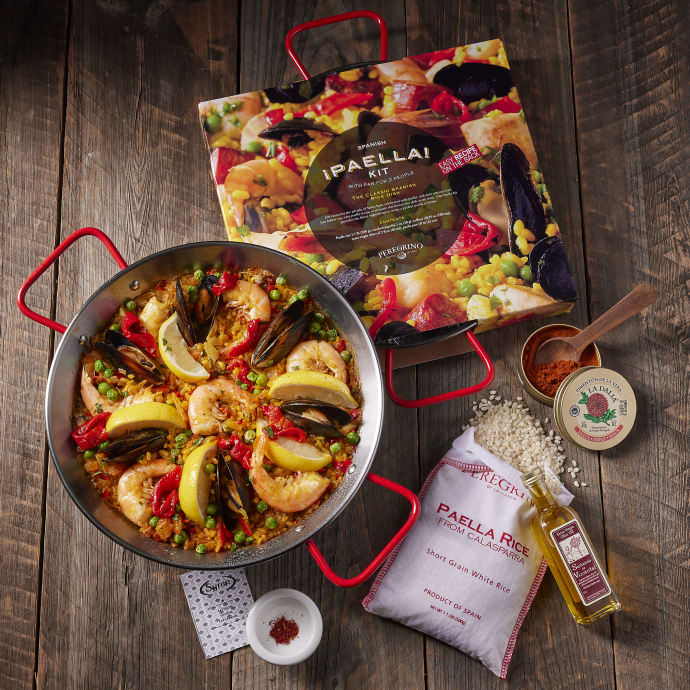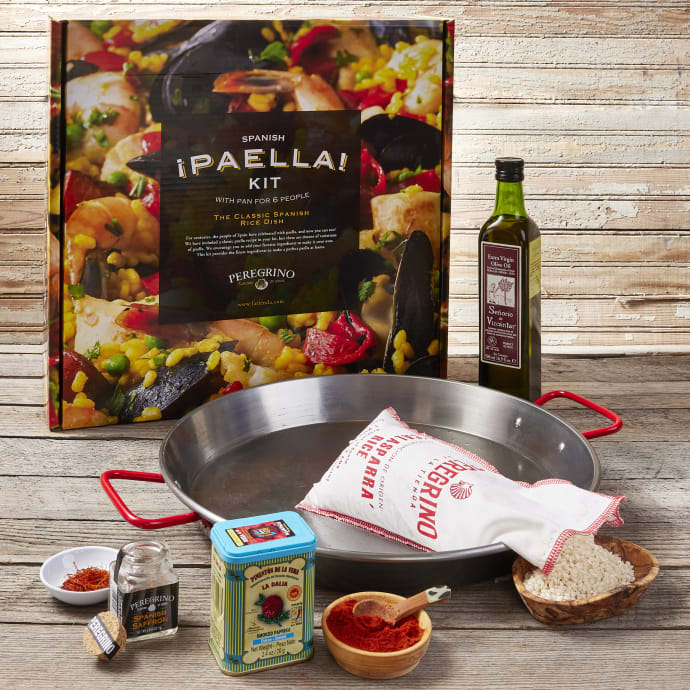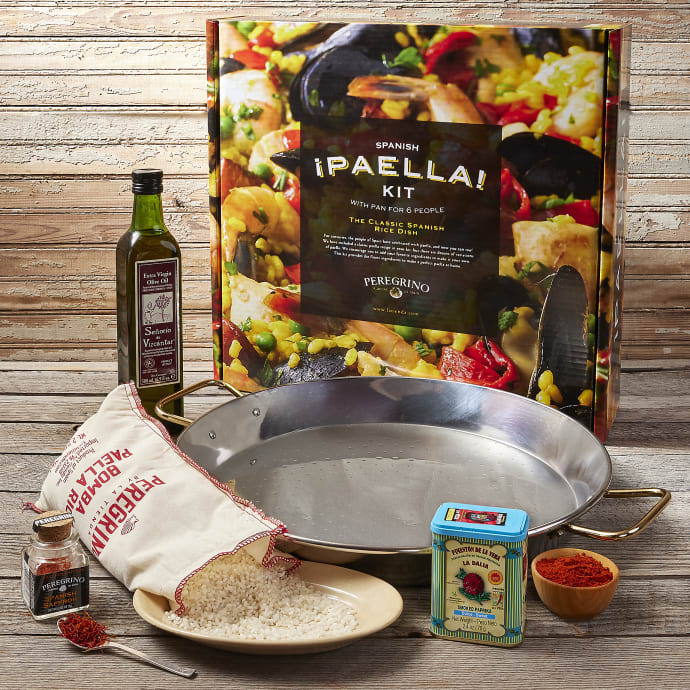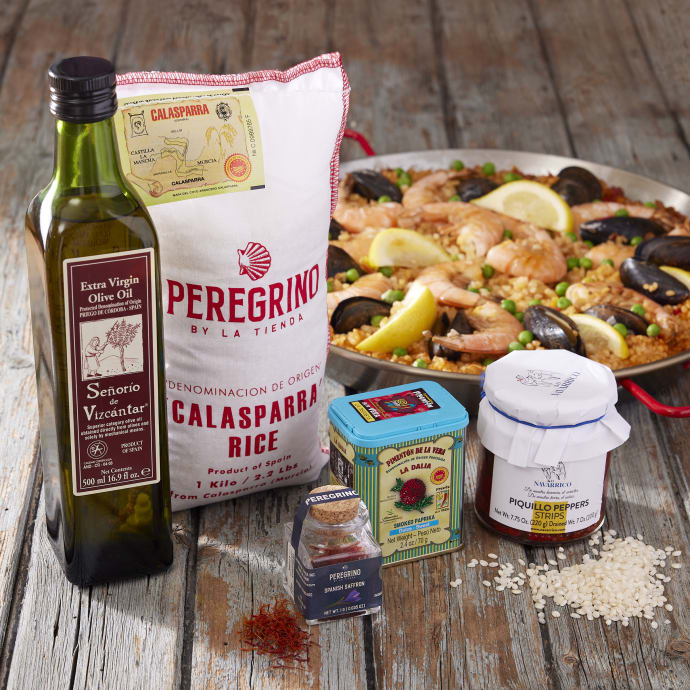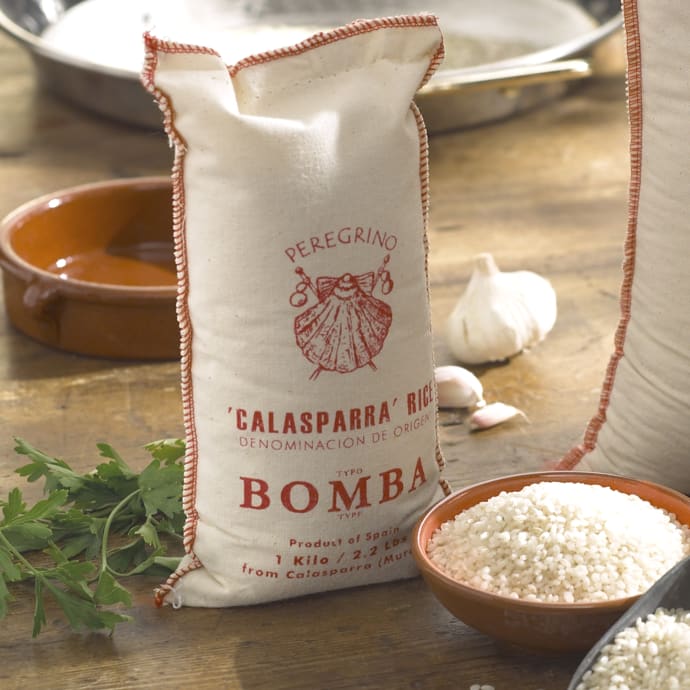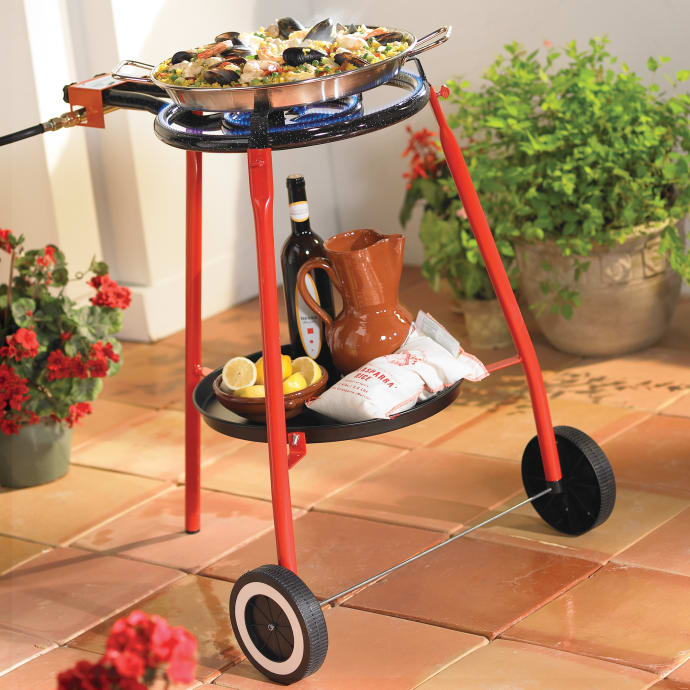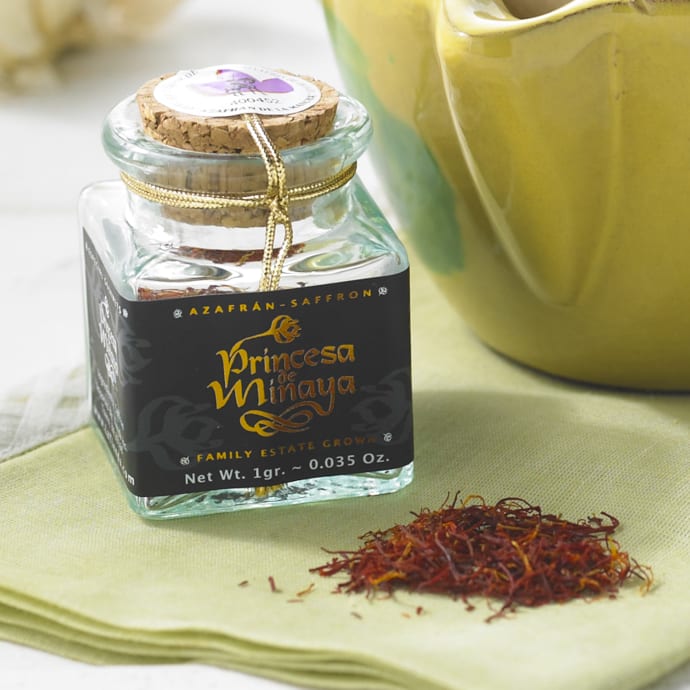Three Kings Sale - Up to 40% Off! Shop Sale

Paella is Spain's gift, to be enjoyed with gusto -- and saffron
Pittsburgh Post-Gazette
-
July 20, 2006
Marlene Parrish
VALENCIA, SPAIN -- Every travel destination has its bragging rights. London has impressive museums. Tuscany claims food. Napa has wine. Rome has architecture. The Caribbean has climate. Miami has a beach.
But there is no need for separate vacations. Valencia has it all.
My husband, Bob, and I can't see enough of Spain, and we travel there as often as we can. A few weeks ago, double bait drew us to Valencia, a city of close to 2 million people about halfway down the country's Mediterranean coast.
We were eager to see the new City of Arts and Sciences complex, where Lorin Maazel has been named the first music director of the performing arts center, a wildly contemporary venue designed by Valencian-born architect Santiago Calatrava. And we wanted to hang out on Valencia's beachfront, more than four miles of 100-yard-wide (really!) public beach, just minutes from the city's center.
Sightseeing, visiting with friends and casual poking around are our pastimes. But eating and learning about regional food specialties are our passion.
For most folks, breakfasts are a highly personal affair. Bob tolerates only breakfast pastries, but I choose the thinnest slices of Iberico ham (hands down the world's best), local cheeses, pan tomate (grated tomato on grilled toast with olive oil) and black coffee.
Valencians go for fartons, glazed yeast pastries the shape of hot dog buns, and dunk them in glasses of chilled horchata, a sweet, white beverage also called tiger nut milk. The duo is the local version of after-school cookies and milk.
Supper comes after 10 p.m., when it's still light in Spain. We make the rounds of the tapas bars in the barrios of the old walled city. Half a dozen bars and several dozen tapas later, we mosey back to the hotel at midnight. But for the Valencians, the night is just beginning, and pubs will be open until early morning.
Midday is the heaviest meal in the Spanish day, and it's eaten about 2 p.m., followed by a welcome siesta. When in Spain, we eat as the Spanish eat. And paella and its many rice-dish cousins often are our meals of choice.
Paella, a Spanish classic
Even though paella (pronounced natively as pa-EL-ya; more common in the United States is the Mexican pie-AY-ya) is known as the national dish of Spain; it is a regional specialty, and of the 13 autonomous regions of the country, Valencia is the epicenter of this emblematic dish.
In Valencia, restaurant menus have a featured section for their rice specialties.
Arroz negra, shockingly black, is rice paella and squid with its ink. Senyoret is rice with seafood, and there are others made with quail, lobster, duck or crab.
Hispania, the Roman name for Spain, means "land of rabbits." Because they hippety-hop all over the country, rabbit is a common ingredient in traditional cooking, found in many dishes, especially Valencia's original farmers paella, paella de conejo.
Fideua, a Valencian specialty, is paella made with narrow, macaroni-shaped pasta with a hole as thin as a pin.
Obviously, paella doesn't have a fixed identity or recipe. That's what makes it so easy on the cook and the purse.
The only essential ingredients of any paella are olive oil, saffron and rice, the three main staples of the Spanish agriculture and economy.
Toppings can include shellfish, chorizo sausage, snails, chicken, rabbit, lobster, crab, peppers, chickpeas, tomatoes, beans, garlic and whatever else may be in the garden. Usually, Spanish cooks will make all-seafood, or all-poultry or -meat, but not a mixture.
But no matter what the traditionalists say about not pairing meat with seafood, most Americans I know poke around in the paella looking for the snappy bite of chorizo before they go for anything else.
When paella goes topless, it's called arroz a banda, as flavorsome a dish as you can imagine, infused with essences of seafoods, herbs, rich fish broth and olive oil.
Largely unknown to Americans, this is perhaps the icon of Spanish paella. Garlic mayonnaise, called aioli, is the essential condiment.
Above, saffron, in jar, and bomba rice make the best paella.
Rice matters
Paella is all about the rice. Spanish short-grain rice defines the dish and gives it its toothsome texture.
Rice has been in the Iberian peninsula since the 8th century. Europe's first rice fields were sown in the wetlands along the Mediterranean coast of Spain, in an area surrounding the Albufera, a freshwater lagoon near Valencia.
The very first paellas were made by rice threshers in the marshlands, who made midday meals over open fires.
The wide, flat, two-handled paella pan allowed food to be cooked quickly, using a minimum of fuel.
The initial dishes were rice and broth. Later, more ingredients gave it substance.
The reapers might catch a rabbit, bag a wild duck or pick vegetables from a nearby plot, adding whatever was in season.
In homes today, paella is a Sunday dinner dish. It is always served in the afternoon, never at night, and usually cooked outdoors by men and perfumed with wood smoke.
The best short-grain rice is a local variety called bomba. It doubles, even triples, in length when cooked, and is forgiving because it doesn't get gummy and stick together.
Senia, bahia and calasparra rice are also as good, but when they are hard to find, Arborio can be a substitute in a pinch. You can't use long-grain or Asian varieties.
Bomba rice can be ordered on the Web at www.tienda.com.Arborio rice can be found at most groceries in the international or ethnic food aisles.
An American party dish
Paella is a no-worries, great summer entree, the ultimate one-dish main course for entertaining.
Presentation is beautiful, even dramatic.
It suits a buffet or a group seated around a table, and paella can be eaten hot out of the oven or at room temperature. Once you've done the shopping, most of the prepping can be done in advance. If you can saute, you can make a paella.
Want to buy a paella dinner before you try to make your own? Not a good idea. It's highly unlikely you'll find a decent one in a restaurant.
Often, turmeric or yellow food coloring is used instead of expensive saffron. The rice isn't the genuine kind, and the toppings might be precooked and plopped on the rice, probably Uncle Ben's, instead of being an integral part of the dish.
No, it's better to make paella yourself. Here are some things to consider.
Use a classic paella pan, or at least one that is shallow, flat-bottomed, slope-sided and has two handles. A 14-to-16-inch pan serves six to eight and will fit into the oven. A wide, shallow casserole will work in a pinch, but the rice will be soupy.
Estimate 1/2 cup of short grain rice per serving. The ideal rice will be moist, plump and tender with the flavor of every ingredient in every grain.
Broth is the key to flavor and quality. Whether you use homemade or canned broth, kick up the flavor. After sauteing chicken, for instance, deglaze the pan with some of the broth. Or, reserve the shrimp shells and saute them in olive oil until they turn pink. Then add some broth and simmer for five minutes. Strain the seasoned broth, discarding the shells.
Use saffron. Expensive, yes. Optional, no. Saffron threads add unique flavor and the classic color. Crush threads between two teaspoons and steep in some of the broth to extract both hue and essence. Saffron is available at Pennsylvania Macaroni Co. and Penzeys Spices in the Strip District, at Whole Foods, East Liberty, and at larger Giant Eagle groceries.
Make the paella in three steps. Compose the dish on top of the range and cook halfway. Place in the oven until almost done. Then allow the paella to rest, out of the oven and covered, where the rice will absorb the remaining broth and finish cooking.
This is showbiz. Bring the pan to the table for oohs and ahhs. Traditionally, paella is eaten communally, right from the pan. For American sensitivities, the host can spoon out portions. Garlic mayonnaise is the ideal condiment.
For a party menu, offer olives and toasted almonds with a glass of dry sherry. At home, pour a rioja wine, but at a picnic, sangria or rose is a good choice. A dessert of chilled, pinwheel-cut orange slices is refreshing.
Add fresh figs, a dish of dark chocolate and take your bows.
See? Not hard at all.
AMERICA'S FAVORITE SEAFOOD PAELLA / 16-INCH PAN
PG TESTED
This recipe goes step-by-step for your success. Do all of the advance sauteing in a large, preferably black iron skillet, rather than in the paella pan, because the skillet's idiosyncrasies will be familiar to you and therefore reliable. Also, the skillet is a better fit to the stovetop burner than a large paella pan. When guests come, just turn on the oven, compose the dish in the paella pan and allow it to bake until the rice is cooked.
Note: Do not crowd the surface of the rice in the pan. If you want more seafood, cook it separately.
Here's the step-by-step method. The recipe uses a 16-inch paella pan. We bought our pans in Valencia. Why that size? Because they fit into the suitcases.
• 24 small clams in the shell, cleaned
• 12 to 20 mussels in the shell, cleaned and beards removed
• 1 1/4 pound shrimp, peeled and deveined, shells reserved
• 5 to 6 cups chicken or fish broth
• 1/2 teaspoon crushed saffron (a good pinch of the strands)
• 1/2 pound chorizo sausage (optional)
• 3 tablespoons olive oil, about
• 1 large onion, chopped fine
• 1 red pepper, chopped fine
• 1 yellow pepper, chopped fine
• 6 cloves garlic, chopped fine
• 1/2 teaspoon smoked Spanish paprika (pimenton)
• Salt and freshly ground pepper
• 2 1/2 cups Spanish short-grain rice, bomba preferred
• 1/4 cup fresh or frozen peas, defrosted
• Lemon wedges, for garnish
• Aioli (garlic mayonnaise), recipe follows
Advance preparation:
Discard any clams that do not close when tapped. Scrub them under running water. Discard any mussels that do not close when tapped. Scrub under running water. Place both in a bowl and refrigerate. Clean shrimp (reserve shells), remove black vein and refrigerate.
To enhance the flavor of the broth, place reserved shrimp shells in a saute pan with a little olive oil. Heat and cook until they turn red. Add 1 1/2 cups of chicken broth to the pan and let it simmer quietly for about 5 minutes. Strain the broth into a glass measure. Discard the shells.
Crush the saffron between 2 spoons or with the fingers. Place the crushed saffron along with a few strands of whole saffron into the hot broth to steep. Add enough additional chicken broth to make 5 cups. Place 1 cup additional plain broth off to the side. You may or may not need some of it.
Cut chorizo, if using, into 4-inch lengths and simmer in water for 15 minutes. Cool and slice into 1/4-inch slices. Set aside.
Heat oil in a skillet. Add the chopped onion and peppers to the oil and saute over medium-low heat until the vegetables are softened, about 10 minutes. Add the garlic and paprika and cook another 2 minutes, but do not let the garlic brown. The vegetables are called the sofrito. Sprinkle with salt and pepper. Set the sofrito aside to cool.
Finish the dish:
Preheat the oven to 400 degrees and place an oven rack on the lowest position. Then, about 35 minutes before you want to serve, begin to assemble the dish.
Place the sofrito in a 16-inch paella pan, spreading it out. Distribute the rice over the vegetables and stir to coat. On another burner in a medium saucepan, bring 5 cups broth to simmer.
Pour the broth over the rice and vegetables.
Bring to a boil on top of the stove, lower the heat and simmer for 10 minutes. Do not stir.
Turn off the heat. Add sausage slices, pushing them into the rice. Add shrimp. Add clams and mussels, hinges down.
Carefully place the paella in the oven and bake for 10 to 12 minutes. Check the dish. If the rice seems too dry, add part of the reserved 1 cup broth. Do not stir the rice. When done, the shellfish will be open and the rice should have a bit of a bite. If necessary, bake 3 minutes longer.
Remove the paella from the oven. Toss the peas over the dish. Cover with a tea towel or foil and allow it to rest for 5 minutes. As it stands, the remaining liquid will be absorbed and the rice will become tender. This is a very important step.
Garnish with lemon wedges. Place the paella directly onto the center of the table and allow guests to help themselves. Pass garlic mayonnaise.
Serves 6 to 8.
-- Marlene Parrish
Egg warning
The American Egg Board has warned against consuming raw or lightly cooked eggs on the grounds that the egg may be contaminated with Salmonella, a bacteria responsible for a type of foodborne illness.
To ensure food safety, replace all raw or lightly cooked eggs in recipes with cooked eggs, or use pasteurized egg products such as Egg Beaters.
To cook eggs but keep them liquid, stir together the whole eggs or yolks with some liquid from the recipe (at least 2 tablespoons liquid per yolk).
Cook over very low heat, stirring constantly, until the yolk mixture coats a metal spoon with a thin film, bubbles at the edges or reaches 160 degrees Fahrenheit. Immediately place the saucepan in ice water and stir until the whole egg or yolk mixture is cool. Continue with the recipe.
-- Amy McConnell Schaarsmith
SMOKY GARLIC MAYONNAISE (AIOLI)
PG TESTED
This is a classic accompaniment to paella. Serve leftover mayo as a dip for raw vegetables or serve with fish. A blender does the smoothest job.
• 1 large egg
• 1 teaspoon smoked Spanish paprika (pimenton)
• 1/2 teaspoon dry mustard
• 1/2 teaspoon salt
• 2 tablespoons vinegar
• 1 cup lightly flavored extra virgin olive oil
• 1 or 2 large cloves garlic, roughly chopped
Break the egg into the blender container. Add pimenton, mustard, salt and vinegar. Add 2 tablespoons of the oil. Cover, and turn the motor onto low speed.
Immediately uncover and pour in the remaining oil in a fine, steady stream. Do not hurry. When all of the oil has been incorporated, add the chopped garlic. Continue to blend for 1 minute until smooth.
Allow the mayonnaise to rest in the refrigerator for at least an hour before using so the flavors will mellow and soften. Refrigerate for up to 4 days. Don't serve it cold because chilling dulls the olive oil flavor.
Makes about 1 1/4 cups.
-- Marlene Parrish
RABBIT PAELLA WITH RED PEPPER AND ALMONDS / 16-INCH PAN
This classic rabbit paella has a hint of
sweetness from the red pepper and subtle flavor from the almonds and garlic. Want to use chicken instead of rabbit? They are interchangeable, but because rabbit is never served with skin, substitute skinless chicken. (I prefer juicy thighs.) This paella also can be made in a fireproof earthenware casserole instead of a paella pan. The result, however, is a slightly moist rice.
• One 2-1/2-pound rabbit, small chicken or chicken thighs, skin and fat removed
• 2 tablespoons slivered blanched almonds
• 1 1/4 cups canned chickpeas (drained and rinsed), reserve the liquid
• About 5 to 5 1/2 cups chicken broth, canned or homemade
• 4 cloves garlic, minced
• 2 tablespoons minced parsley
• 1/2 teaspoon smoked Spanish paprika (pimenton)
• 1/4 teaspoon crumbled thread saffron
• Kosher or sea salt
• 4 tablespoons olive oil
• 1 medium onion, finely chopped
• 1 red pepper, diced
• 2 medium tomatoes, finely chopped
• 2 1/2 cups imported Spanish rice (bomba preferred) or Arborio short-grain rice
Cut the rabbit or chicken with kitchen shears into pieces about 2 inches in size. If using thighs, leave whole. (Discard the bony tips of the rabbit legs.) Sprinkle all over with salt.
Toast the almonds on a cookie sheet in a 350-degree oven until lightly brown, about 4 minutes. Combine the liquid from the chickpeas with the broth to make 5 1/2 cups. Mash 1/2 cup of the chickpeas through a strainer into the broth. Reserve the remaining 3/4 cup chickpeas for the rice. (If there are extra, keep for some other use.)
In a mortar or mini-processor, mash to a paste the garlic, parsley, pimento, saffron, almonds and 1/4 teaspoon salt. Mash in 1 tablespoon of the broth. Set aside.
Preheat the oven to 400 degrees. Place oven rack in the lowest position. Keep the broth hot over the lowest heat.
Do this next part of the preparation in a large skillet. (Your familiar kitchen skillets will conduct heat and fit over the burner better than the paella pan.) Heat the oil and saute the rabbit or chicken pieces over high heat about 5 minutes (do not fully cook). Remove to a warm platter. Add the onion and pepper to the skillet and cook slowly until the vegetables are slightly softened. Add the tomatoes, turn up the heat and saute 2 minutes more.
Scrape the vegetables and oil into a 16-inch paella pan. Stir in the rice and coat well with the vegetable mixture. Add the reserved mortar mixture and stir. Then add chickpeas and rabbit or chicken. Pour in 5 cups of broth, bring to a boil then simmer without stirring for 10 minutes.
Taste for salt and correct seasoning.
Transfer the paella to the oven and cook an additional 10 to 12 minutes, or until the rice is almost al dente. Remove to a warm spot, cover with a tea towel and let the dish rest for 5 to 10 minutes until the rice is fully cooked. Serve with garlic mayonnaise on the side.
Makes 6 servings.
-- Adapted from "Paella!", Penelope Casas
VALENCIA, SPAIN -- Every travel destination has its bragging rights. London has impressive museums. Tuscany claims food. Napa has wine. Rome has architecture. The Caribbean has climate. Miami has a beach.
But there is no need for separate vacations. Valencia has it all.
My husband, Bob, and I can't see enough of Spain, and we travel there as often as we can. A few weeks ago, double bait drew us to Valencia, a city of close to 2 million people about halfway down the country's Mediterranean coast.
We were eager to see the new City of Arts and Sciences complex, where Lorin Maazel has been named the first music director of the performing arts center, a wildly contemporary venue designed by Valencian-born architect Santiago Calatrava. And we wanted to hang out on Valencia's beachfront, more than four miles of 100-yard-wide (really!) public beach, just minutes from the city's center.
Sightseeing, visiting with friends and casual poking around are our pastimes. But eating and learning about regional food specialties are our passion.
For most folks, breakfasts are a highly personal affair. Bob tolerates only breakfast pastries, but I choose the thinnest slices of Iberico ham (hands down the world's best), local cheeses, pan tomate (grated tomato on grilled toast with olive oil) and black coffee.
Valencians go for fartons, glazed yeast pastries the shape of hot dog buns, and dunk them in glasses of chilled horchata, a sweet, white beverage also called tiger nut milk. The duo is the local version of after-school cookies and milk.
Supper comes after 10 p.m., when it's still light in Spain. We make the rounds of the tapas bars in the barrios of the old walled city. Half a dozen bars and several dozen tapas later, we mosey back to the hotel at midnight. But for the Valencians, the night is just beginning, and pubs will be open until early morning.
Midday is the heaviest meal in the Spanish day, and it's eaten about 2 p.m., followed by a welcome siesta. When in Spain, we eat as the Spanish eat. And paella and its many rice-dish cousins often are our meals of choice.
Paella, a Spanish classic
Even though paella (pronounced natively as pa-EL-ya; more common in the United States is the Mexican pie-AY-ya) is known as the national dish of Spain; it is a regional specialty, and of the 13 autonomous regions of the country, Valencia is the epicenter of this emblematic dish.
In Valencia, restaurant menus have a featured section for their rice specialties.
Arroz negra, shockingly black, is rice paella and squid with its ink. Senyoret is rice with seafood, and there are others made with quail, lobster, duck or crab.
Hispania, the Roman name for Spain, means "land of rabbits." Because they hippety-hop all over the country, rabbit is a common ingredient in traditional cooking, found in many dishes, especially Valencia's original farmers paella, paella de conejo.
Fideua, a Valencian specialty, is paella made with narrow, macaroni-shaped pasta with a hole as thin as a pin.
Obviously, paella doesn't have a fixed identity or recipe. That's what makes it so easy on the cook and the purse.
The only essential ingredients of any paella are olive oil, saffron and rice, the three main staples of the Spanish agriculture and economy.
Toppings can include shellfish, chorizo sausage, snails, chicken, rabbit, lobster, crab, peppers, chickpeas, tomatoes, beans, garlic and whatever else may be in the garden. Usually, Spanish cooks will make all-seafood, or all-poultry or -meat, but not a mixture.
But no matter what the traditionalists say about not pairing meat with seafood, most Americans I know poke around in the paella looking for the snappy bite of chorizo before they go for anything else.
When paella goes topless, it's called arroz a banda, as flavorsome a dish as you can imagine, infused with essences of seafoods, herbs, rich fish broth and olive oil.
Largely unknown to Americans, this is perhaps the icon of Spanish paella. Garlic mayonnaise, called aioli, is the essential condiment.
Above, saffron, in jar, and bomba rice make the best paella.
Rice matters
Paella is all about the rice. Spanish short-grain rice defines the dish and gives it its toothsome texture.
Rice has been in the Iberian peninsula since the 8th century. Europe's first rice fields were sown in the wetlands along the Mediterranean coast of Spain, in an area surrounding the Albufera, a freshwater lagoon near Valencia.
The very first paellas were made by rice threshers in the marshlands, who made midday meals over open fires.
The wide, flat, two-handled paella pan allowed food to be cooked quickly, using a minimum of fuel.
The initial dishes were rice and broth. Later, more ingredients gave it substance.
The reapers might catch a rabbit, bag a wild duck or pick vegetables from a nearby plot, adding whatever was in season.
In homes today, paella is a Sunday dinner dish. It is always served in the afternoon, never at night, and usually cooked outdoors by men and perfumed with wood smoke.
The best short-grain rice is a local variety called bomba. It doubles, even triples, in length when cooked, and is forgiving because it doesn't get gummy and stick together.
Senia, bahia and calasparra rice are also as good, but when they are hard to find, Arborio can be a substitute in a pinch. You can't use long-grain or Asian varieties.
Bomba rice can be ordered on the Web at www.tienda.com.Arborio rice can be found at most groceries in the international or ethnic food aisles.
An American party dish
Paella is a no-worries, great summer entree, the ultimate one-dish main course for entertaining.
Presentation is beautiful, even dramatic.
It suits a buffet or a group seated around a table, and paella can be eaten hot out of the oven or at room temperature. Once you've done the shopping, most of the prepping can be done in advance. If you can saute, you can make a paella.
Want to buy a paella dinner before you try to make your own? Not a good idea. It's highly unlikely you'll find a decent one in a restaurant.
Often, turmeric or yellow food coloring is used instead of expensive saffron. The rice isn't the genuine kind, and the toppings might be precooked and plopped on the rice, probably Uncle Ben's, instead of being an integral part of the dish.
No, it's better to make paella yourself. Here are some things to consider.
Use a classic paella pan, or at least one that is shallow, flat-bottomed, slope-sided and has two handles. A 14-to-16-inch pan serves six to eight and will fit into the oven. A wide, shallow casserole will work in a pinch, but the rice will be soupy.
Estimate 1/2 cup of short grain rice per serving. The ideal rice will be moist, plump and tender with the flavor of every ingredient in every grain.
Broth is the key to flavor and quality. Whether you use homemade or canned broth, kick up the flavor. After sauteing chicken, for instance, deglaze the pan with some of the broth. Or, reserve the shrimp shells and saute them in olive oil until they turn pink. Then add some broth and simmer for five minutes. Strain the seasoned broth, discarding the shells.
Use saffron. Expensive, yes. Optional, no. Saffron threads add unique flavor and the classic color. Crush threads between two teaspoons and steep in some of the broth to extract both hue and essence. Saffron is available at Pennsylvania Macaroni Co. and Penzeys Spices in the Strip District, at Whole Foods, East Liberty, and at larger Giant Eagle groceries.
Make the paella in three steps. Compose the dish on top of the range and cook halfway. Place in the oven until almost done. Then allow the paella to rest, out of the oven and covered, where the rice will absorb the remaining broth and finish cooking.
This is showbiz. Bring the pan to the table for oohs and ahhs. Traditionally, paella is eaten communally, right from the pan. For American sensitivities, the host can spoon out portions. Garlic mayonnaise is the ideal condiment.
For a party menu, offer olives and toasted almonds with a glass of dry sherry. At home, pour a rioja wine, but at a picnic, sangria or rose is a good choice. A dessert of chilled, pinwheel-cut orange slices is refreshing.
Add fresh figs, a dish of dark chocolate and take your bows.
See? Not hard at all.
AMERICA'S FAVORITE SEAFOOD PAELLA / 16-INCH PAN
PG TESTED
This recipe goes step-by-step for your success. Do all of the advance sauteing in a large, preferably black iron skillet, rather than in the paella pan, because the skillet's idiosyncrasies will be familiar to you and therefore reliable. Also, the skillet is a better fit to the stovetop burner than a large paella pan. When guests come, just turn on the oven, compose the dish in the paella pan and allow it to bake until the rice is cooked.
Note: Do not crowd the surface of the rice in the pan. If you want more seafood, cook it separately.
Here's the step-by-step method. The recipe uses a 16-inch paella pan. We bought our pans in Valencia. Why that size? Because they fit into the suitcases.
• 24 small clams in the shell, cleaned
• 12 to 20 mussels in the shell, cleaned and beards removed
• 1 1/4 pound shrimp, peeled and deveined, shells reserved
• 5 to 6 cups chicken or fish broth
• 1/2 teaspoon crushed saffron (a good pinch of the strands)
• 1/2 pound chorizo sausage (optional)
• 3 tablespoons olive oil, about
• 1 large onion, chopped fine
• 1 red pepper, chopped fine
• 1 yellow pepper, chopped fine
• 6 cloves garlic, chopped fine
• 1/2 teaspoon smoked Spanish paprika (pimenton)
• Salt and freshly ground pepper
• 2 1/2 cups Spanish short-grain rice, bomba preferred
• 1/4 cup fresh or frozen peas, defrosted
• Lemon wedges, for garnish
• Aioli (garlic mayonnaise), recipe follows
Advance preparation:
Discard any clams that do not close when tapped. Scrub them under running water. Discard any mussels that do not close when tapped. Scrub under running water. Place both in a bowl and refrigerate. Clean shrimp (reserve shells), remove black vein and refrigerate.
To enhance the flavor of the broth, place reserved shrimp shells in a saute pan with a little olive oil. Heat and cook until they turn red. Add 1 1/2 cups of chicken broth to the pan and let it simmer quietly for about 5 minutes. Strain the broth into a glass measure. Discard the shells.
Crush the saffron between 2 spoons or with the fingers. Place the crushed saffron along with a few strands of whole saffron into the hot broth to steep. Add enough additional chicken broth to make 5 cups. Place 1 cup additional plain broth off to the side. You may or may not need some of it.
Cut chorizo, if using, into 4-inch lengths and simmer in water for 15 minutes. Cool and slice into 1/4-inch slices. Set aside.
Heat oil in a skillet. Add the chopped onion and peppers to the oil and saute over medium-low heat until the vegetables are softened, about 10 minutes. Add the garlic and paprika and cook another 2 minutes, but do not let the garlic brown. The vegetables are called the sofrito. Sprinkle with salt and pepper. Set the sofrito aside to cool.
Finish the dish:
Preheat the oven to 400 degrees and place an oven rack on the lowest position. Then, about 35 minutes before you want to serve, begin to assemble the dish.
Place the sofrito in a 16-inch paella pan, spreading it out. Distribute the rice over the vegetables and stir to coat. On another burner in a medium saucepan, bring 5 cups broth to simmer.
Pour the broth over the rice and vegetables.
Bring to a boil on top of the stove, lower the heat and simmer for 10 minutes. Do not stir.
Turn off the heat. Add sausage slices, pushing them into the rice. Add shrimp. Add clams and mussels, hinges down.
Carefully place the paella in the oven and bake for 10 to 12 minutes. Check the dish. If the rice seems too dry, add part of the reserved 1 cup broth. Do not stir the rice. When done, the shellfish will be open and the rice should have a bit of a bite. If necessary, bake 3 minutes longer.
Remove the paella from the oven. Toss the peas over the dish. Cover with a tea towel or foil and allow it to rest for 5 minutes. As it stands, the remaining liquid will be absorbed and the rice will become tender. This is a very important step.
Garnish with lemon wedges. Place the paella directly onto the center of the table and allow guests to help themselves. Pass garlic mayonnaise.
Serves 6 to 8.
-- Marlene Parrish
Egg warning
The American Egg Board has warned against consuming raw or lightly cooked eggs on the grounds that the egg may be contaminated with Salmonella, a bacteria responsible for a type of foodborne illness.
To ensure food safety, replace all raw or lightly cooked eggs in recipes with cooked eggs, or use pasteurized egg products such as Egg Beaters.
To cook eggs but keep them liquid, stir together the whole eggs or yolks with some liquid from the recipe (at least 2 tablespoons liquid per yolk).
Cook over very low heat, stirring constantly, until the yolk mixture coats a metal spoon with a thin film, bubbles at the edges or reaches 160 degrees Fahrenheit. Immediately place the saucepan in ice water and stir until the whole egg or yolk mixture is cool. Continue with the recipe.
-- Amy McConnell Schaarsmith
SMOKY GARLIC MAYONNAISE (AIOLI)
PG TESTED
This is a classic accompaniment to paella. Serve leftover mayo as a dip for raw vegetables or serve with fish. A blender does the smoothest job.
• 1 large egg
• 1 teaspoon smoked Spanish paprika (pimenton)
• 1/2 teaspoon dry mustard
• 1/2 teaspoon salt
• 2 tablespoons vinegar
• 1 cup lightly flavored extra virgin olive oil
• 1 or 2 large cloves garlic, roughly chopped
Break the egg into the blender container. Add pimenton, mustard, salt and vinegar. Add 2 tablespoons of the oil. Cover, and turn the motor onto low speed.
Immediately uncover and pour in the remaining oil in a fine, steady stream. Do not hurry. When all of the oil has been incorporated, add the chopped garlic. Continue to blend for 1 minute until smooth.
Allow the mayonnaise to rest in the refrigerator for at least an hour before using so the flavors will mellow and soften. Refrigerate for up to 4 days. Don't serve it cold because chilling dulls the olive oil flavor.
Makes about 1 1/4 cups.
-- Marlene Parrish
RABBIT PAELLA WITH RED PEPPER AND ALMONDS / 16-INCH PAN
This classic rabbit paella has a hint of
sweetness from the red pepper and subtle flavor from the almonds and garlic. Want to use chicken instead of rabbit? They are interchangeable, but because rabbit is never served with skin, substitute skinless chicken. (I prefer juicy thighs.) This paella also can be made in a fireproof earthenware casserole instead of a paella pan. The result, however, is a slightly moist rice.
• One 2-1/2-pound rabbit, small chicken or chicken thighs, skin and fat removed
• 2 tablespoons slivered blanched almonds
• 1 1/4 cups canned chickpeas (drained and rinsed), reserve the liquid
• About 5 to 5 1/2 cups chicken broth, canned or homemade
• 4 cloves garlic, minced
• 2 tablespoons minced parsley
• 1/2 teaspoon smoked Spanish paprika (pimenton)
• 1/4 teaspoon crumbled thread saffron
• Kosher or sea salt
• 4 tablespoons olive oil
• 1 medium onion, finely chopped
• 1 red pepper, diced
• 2 medium tomatoes, finely chopped
• 2 1/2 cups imported Spanish rice (bomba preferred) or Arborio short-grain rice
Cut the rabbit or chicken with kitchen shears into pieces about 2 inches in size. If using thighs, leave whole. (Discard the bony tips of the rabbit legs.) Sprinkle all over with salt.
Toast the almonds on a cookie sheet in a 350-degree oven until lightly brown, about 4 minutes. Combine the liquid from the chickpeas with the broth to make 5 1/2 cups. Mash 1/2 cup of the chickpeas through a strainer into the broth. Reserve the remaining 3/4 cup chickpeas for the rice. (If there are extra, keep for some other use.)
In a mortar or mini-processor, mash to a paste the garlic, parsley, pimento, saffron, almonds and 1/4 teaspoon salt. Mash in 1 tablespoon of the broth. Set aside.
Preheat the oven to 400 degrees. Place oven rack in the lowest position. Keep the broth hot over the lowest heat.
Do this next part of the preparation in a large skillet. (Your familiar kitchen skillets will conduct heat and fit over the burner better than the paella pan.) Heat the oil and saute the rabbit or chicken pieces over high heat about 5 minutes (do not fully cook). Remove to a warm platter. Add the onion and pepper to the skillet and cook slowly until the vegetables are slightly softened. Add the tomatoes, turn up the heat and saute 2 minutes more.
Scrape the vegetables and oil into a 16-inch paella pan. Stir in the rice and coat well with the vegetable mixture. Add the reserved mortar mixture and stir. Then add chickpeas and rabbit or chicken. Pour in 5 cups of broth, bring to a boil then simmer without stirring for 10 minutes.
Taste for salt and correct seasoning.
Transfer the paella to the oven and cook an additional 10 to 12 minutes, or until the rice is almost al dente. Remove to a warm spot, cover with a tea towel and let the dish rest for 5 to 10 minutes until the rice is fully cooked. Serve with garlic mayonnaise on the side.
Makes 6 servings.
-- Adapted from "Paella!", Penelope Casas
Other Press
The Winter Travel Shortlist: Problem-Solving Essentials I’m Packing This Season
Forbes
-
November 20, 2025
54 Gifts for People Who Have Everything
Wirecutter
-
November 6, 2025
What Andrew Zimmern Can’t Live Without
The Strategist
-
June 30, 2025
8 Tasty Ways To Travel The World With Food
Forbes
-
June 17, 2025
Featured Products
 SHIPS FREE
SHIPS FREEMini Paella Kit with Pan in Gift Box by Peregrino - FREE SHIPPING!
PA-10
(39)
$69.00$69.00
 SALE
SALETraditional Paella Kit with Pan by Peregrino - FREE SHIPPING!
PA-02
(24)
$129.00 $125.00
 SALE
SALEDeluxe Paella Kit with Stainless Pan by Peregrino - FREE SHIPPING!
PA-07
(6)
$269.00 $199.00
 BEST SELLER
BEST SELLEREssential Paella Ingredients
PA-05
(32)
$85.00$85.00
 SALE
SALEBomba Paella Rice by Peregrino
RC-03
(110)
$25.00 $21.00

Paella Burner with Rolling Stand and FREE 17 inch Pan
PB-06B
(7)
$399.00$399.00

Princesa de Minaya Saffron, D.O. La Mancha
SN-09
(53)
$27.00$27.00

